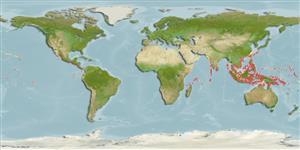Classification / Names
Common names from other countries
Main reference
Size / Weight / Age
Max length : 70.0 cm TL male/unsexed; (Ref. 9710)
Environment
Marine; reef-associated; depth range 1 - 25 m (Ref. 90102)
Climate / Range
Tropical, preferred ?; 30°N - 13°S
Distribution
Indo-West Pacific: Maldives to New Ireland in Papua New Guinea, including Cocos-Keeling Islands, north to Ryukyu Islands and south to the Philippines, including Palau. This species is the terminal male of Scarus singaporensis. Possibly replaced by Scarus falcipinnis in the western Indian Ocean (Ref. 2689).
Countries | FAO areas | Ecosystems | Occurrences | Introductions
Short description
Dorsal
spines
(total): 9;
Dorsal
soft rays
(total): 10;
Anal
spines: 3;
Anal
soft rays: 9. Scales large. Median predorsal scales 6; 3 scale rows on cheek, with 1-3 scales in ventral row. Caudal fins emarginate in initial phase to deeply concave in large terminal phase. Lips nearly covering dental plates; terminal males with 0-2 canines posteriorly on side of upper plate, none on lower. The initial phase closely resembles that of S. altipinnis (Ref. 1602). The terminal phase has the distinctive brilliant green throat and lacks the filamentous middle dorsal spine (Ref. 1602).
IUCN Red List Status (Ref. 115185)
Threat to humans
Harmless
Human uses
Fisheries: commercial; aquarium: commercial
More information
ReferencesAquacultureAquaculture profileStrainsGeneticsAllele frequenciesHeritabilityDiseasesProcessingMass conversion
Tools
Special reports
Download XML
Internet sources
Estimates of some properties based on models
Phylogenetic diversity index
PD50 = 0.5000 many relatives (e.g. carps) 0.5 - 2.0 few relatives (e.g. lungfishes)
Trophic Level
2.0 ±0.0 se; Based on diet studies.
Resilience
Medium, minimum population doubling time 1.4 - 4.4 years (Preliminary K or Fecundity.)
Vulnerability
Moderate vulnerability (39 of 100)
Price category
